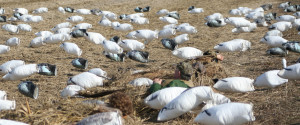 You gained permission for the hot spot hunting grounds last night, so now you’re going to hunt the X where the birds were feeding. You set up the perfect decoy spread; high end realistic decoys that are sure to get them on the deck and in your face. But, what you did not do, was put enough care and thought into the concealment of your hunting blinds. Unfortunately, the snow geese saw it from the air and realized they were in danger so they never decoyed into the kill zone. Sound familiar?
You gained permission for the hot spot hunting grounds last night, so now you’re going to hunt the X where the birds were feeding. You set up the perfect decoy spread; high end realistic decoys that are sure to get them on the deck and in your face. But, what you did not do, was put enough care and thought into the concealment of your hunting blinds. Unfortunately, the snow geese saw it from the air and realized they were in danger so they never decoyed into the kill zone. Sound familiar?
Simply put, mudding and brushing your layout blind is one of the most important aspects of any successful snow goose hunt after decoy numbers. One of the most common mistakes new hunters make is assuming that a layout blind is field ready right out of the box; this is hardly the case. Take a blind out of the box and what you have is a new, shiny piece of equipment. It looks pretty, but it need to be prepared before you can take it on any kind of goose hunting trip.
The first thing you need to do with your blind is to mud it up a little bit. To do this, fill a bucket with some “thick” mud and apply it to the blind (you can use a paint brush to do this). Once it is dried, brush it off or not. This will remove the original “sheen” on the material and make it field ready but not hunt ready!
Another consideration is the lay of the land where you are placing your blind. You want the blind to be as low as possible so it is more difficult for the birds to spot. Also, realize the blind has height which mean it creates shadows, so it may require digging shallow area the size and shape of the layout blinds so that when they are placed, they are closer to the height of the surrounding land and vegetation. For instance, you are in a muddy, brush area that rises about a foot high. If your blind is 18” high, you should dig it in at least 6 to 7” so the blind is closer to the natural terrain and vegetation.
If you are pulling up brush for your blind, you need to ensure you are using brush that is consistent with the crop or native brush in that area, but do not pull brush from right around your blinds you will create a trampled down appearance around the blinds or bald spot that will actually make them stand out. Move away from the blind to an area that has like brush and pick your cover from that area. Be careful not to concentrate on any one area, though, as you may inadvertently create the “trampled down and bare” look you are trying to avoid around your blind. Remember, anything out of sorts may cause the birds to take notice.
The most important thing to remember while setting your layout blinds is to make use of the natural terrain so the blind blends in to your hunting area. If the area is muddy, use the surrounding mud to cover the blind but to save time and reduce the hassle it’s a good idea to mud your blinds once you assemble them. If you are in a cornfield, take the time to use the stalks and attach them to your blind making use of the stubble straps. If the ground is covered in snow, use snow covers that can be bought and will fit your blinds or you can use cans of artificial snow. The more natural and lower the blind profile is, the less likely it is to get the unwanted attention of the snow geese on your blinds and keep it on your decoys.












